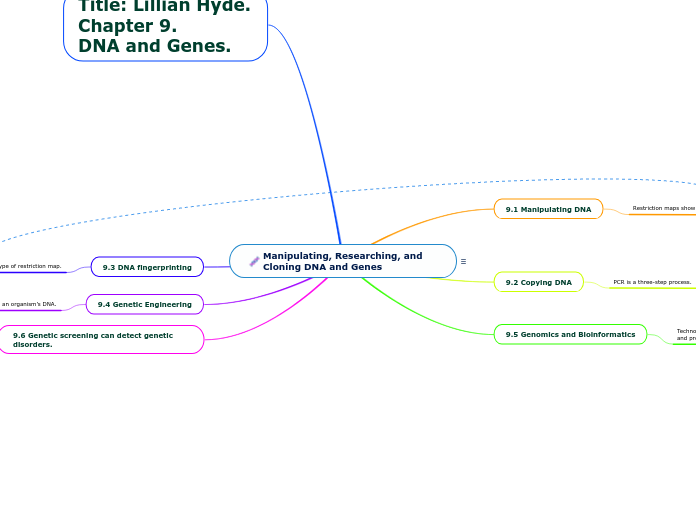Manipulating, Researching, and Cloning DNA and Genes
9.1 Manipulating DNA
Restriction maps show the lengths of DNA fragments.
DNA fragments are seperated and sorted by their size, a tecnique called gel electrophoresis forms part in this process. Gel electrophoresis is an electrical current, a sample of DNA is placed into a gel. Fragments move toward the positive charged pole. The pores in the gel allows small molecules to move quicker. In conclusion: The lenght of a DNA fragment can be estimated from the speed and distance it travels through a gel in a certain time. DNA fragments of different sizes appear as different bands on a gel, and the restriction maps show the lengths of DNA fragments between restriction sites in a strand of DNA.
9.2 Copying DNA
PCR is a three-step process.
Separating: The container with the reactants is heated with the purpose to separate the double stranded DNA. Binding: The container is cooled and the primers bind to their complementary DNA sequences, one primer binds to each DNA strand. The primers bind on opposite ends of the DNA segments. Copying: The container is heated, polymerases build new strands of DNA, new nucleotides bind to the original DNA strands, polymerase continue attaching until the whole DNA segment is copied.
9.5 Genomics and Bioinformatics
Technology allows the study and comparison of both genes and proteins.
Title: Lillian Hyde. Chapter 9. DNA and Genes.
9.3 DNA fingerprinting
A DNA fingerprint is a type of restriction map.
DNA fingerprints can show relationships among family members, it focuses on noncoding regions of DNA. Noncoding DNA sequences include stretches of nucleotides that repeat several times. The differences in the number of repeats are found separating the DNA fragments with gel electrophoresis.
9.4 Genetic Engineering
New genes can be added to an organism’s DNA.
Genetic engineering: Scientist insert cloned genes from one organism to another, giving the second organism new traits.
9.6 Genetic screening can detect genetic disorders.
Some genetic screening tests can detect genes that have a high possibilty of developing a disease. This process can help save lives and prevent many ilnesses.
